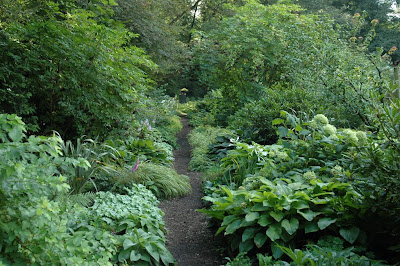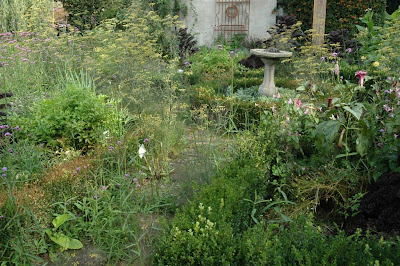I am now finally getting around to the Germany trip of last fall, one of my best garden visiting trips so far. The first garden we went to was Peter Janke's in Hilden (near Dusseldorf), which I learned about through James Golden's Federal Twist blog. Janke is a nurseryman, garden designer, and one of the leading figures in the exciting German landscape design scene.

His garden is a very large, rectangular piece of land, bordered by a very busy road on one side and an impressive mature forest on all others. The driveway bisects the property from the road, and leads to the central house and nursery. The driveway is the first impressive feature of the garden, with a very simple but striking use of Verbena bonarensis as edging along both sides (about 20m long stretch I would guess).
The right half of the front garden is occupied by a simple meadow with a circular pattern of mown grass in the middle, as well as a mown path bordered by fruit trees. At the time of our visit, the grass was uniformly tan in colour, with few other interlaced plants.
The left half of the front garden is taken up by the gravel garden, inspired by Beth Chatto's work in Essex. Peter Janke has studied with Chatto and credits her as a great influence on his work. This garden was absolutely spectacular at the time of our visit on September 4th. Everything seemed to sparkle in the autumn sun: delicate grass blades and seed heads, silver foliage, papery fall blooms and spiky dried flower heads.
At the back of the property lies the woodland garden, where the presence of the mature forest is keenly felt. This garden is cool and wet, in contrast to the open front areas. Simple mulch paths snake through it, along the edge of the forest. The garden is so lush you can hardly see outside of it. Many small and larger ponds are hidden between the foliage, and some were covered in a copper or rust coloured film. I'm not sure what the source of this is, but it made for an interesting contrast with the surrounding green.
Everywhere in the garden, there were little details that caught my eye, such as the interesting border edge below.
Or the wild abundant herb garden, with plants popping up through every crack in the paving, creating that beautiful contrast between geometrical and organic lines.
And the imaginatively pruned or placed trees throughout the property.
It was definitely a treat to be able to visit this garden. It combines a great mix of modern and classic, both in the design and the plants. It might have been even better if I spoke German as Peter Janke did a tour of the garden (we visited on a special open day). Would have loved to learn from what he had to say, although the garden was already a good teacher by itself.











How nice to see you blogging again. And how encouraging - it's been awhile since I've been genuinely excited by some garden blog content. Janke's garden is one of a handful of garden's that Gardens Illustrated has introduced to me that I've actually thought about (pined for?) actively since reading about it. Such a lucky wanderer you are to see such things in real life. Well done...
ReplyDeleteSome how, the more I look at these photos, the more I feel that I should be looking at them from inside the photos; especially those that show a path.
ReplyDeletePeter - Thank you. Yes, I've been very lucky and spoiled since moving to Europe in garden visiting terms - trying not to take it for granted! Janke's garden was definitely a very inspiring place.
ReplyDeleteChen - That's a very interesting observation. Now that I look at the pictures, they do seem to give a feeling of being enveloped by the garden. Is that what you mean?
I meant your photos capture the beauty and charcteristics of this garden so well that I can almost enjoy the garden from inside your photos (like enjoying a Chinese landscape painting from inside the painting rather than being constrained to a 2 dimensional perspective).
ReplyDeleteI want to thank you for visiting Janke's garden and making these photos available. I haven't seen anything about it since Noel Kingsbury's Gardens Illustrated article quite a while back. It's a hard garden to see and your post gives a much needed view into some other aspects of the garden. So much seems to be going on in Germany, and little reaches us through the published media, I suppose because of the language difference. In the fourth photo, at the center, there is a single tall plant with basal leaves that look somewhat like a yucca. This appears to be Eryngium pandanafolium, a plant I saw everywhere on a visit to Uruguay last February (I could certainly be mistaken). I know Janke pushes the climate envelope by growing Mediterranean cypresses in Germany. I'm wondering if this is another example? Did he have a plant list for his garden?
ReplyDeleteChen - Thanks for clarifying, that's a really interesting perspective. I'm glad you enjoyed the photos.
ReplyDeleteJames - You have a keen eye! Unfortunately, I don't think I can really help you - I don't have better photos of the plant, and you're much more of an expert than I am. It does look similar to what you posted from Uruguay, but it would be hard to know without asking Peter Janke himself. And unfortunately there was no plant list for the garden. I've posted some more photos on Flickr if you're interested: Peter Janke garden photos
Haven't been to Peter Jankes garden but I plan to. In German garden magazins he has a regular column and just recently he published the book about his garden: Meine Vision wird Garten, ISBN 978-3-938100-72-1
ReplyDeleteYou can order it through Amazon. Lots of wonderful pictures and you may find also the name of the plant you were looking at!
Angelika